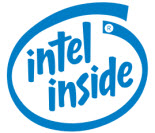Intel wants to be inside the iPad

You know those little 'Intel Inside' sticker that adorn PCs? Well, CEO Paul Otellini has plans to make silicon "so compelling" that Apple will put 'Intel Inside' the iPad.

"Our job," said Otellini, "is to ensure our silicon is so compelling ... in terms of running the Mac better or being a better iPad device, that as they [Apple] make those decisions they can't ignore us."
The A5X processor that currently powers the iPad 3 is system-on-a-chip -- SoC -- part that combines a dual-core CPU at 1 GHz and a quad-core PowerVR SGX543MP4 GPU into a single package. This SoC was designed by Apple and manufactured by Samsung at its plant in Austin, Texas.
But there are problems with the A5X. It is manufactured using 45 nanometer architecture -- architecture that Intel and AMD were using for desktop CPUs back in 2008 -- and over the three incarnations of the iPad the size of the die has increased dramatically. The current A5X is 310 percent larger than the A4 processor that powered the first-generation iPad.
Intel could help Apple change this. Its current line of Ivy Bridge processors is built using 22 nanometer architecture, but the company plans to have mobile processors based on this size of architecture available next year, with 14 nanometer architecture coming in 2014.
Intel already has a mobile processor based on the Medfield 32 nanometer architecture, called the Atom Z2460, which runs at 1.6GHz.
Smaller architecture not only means a smaller processor die, but lower power consumption and less heat. These are two features that are very important when it comes to mobile devices and mobile computing. Intel's expertise in miniaturizing transistors could certainly be beneficial to Apple when it comes to shrinking down the size of the silicon and slashing battery consumption.
Image source: Wikimedia Commons, Intel.
Related:
Best photographic accessories for the iPhone 4 and 4S
| Image Gallery: Best photographic accessories for the iPhone 4/4S | ||||||
- Developer: iOS 5.1.1 already installed on 10 percent of iOS devices
- iOS 5.1.1 update squashes iPad 3 2G/3G network switching bug
- Build your own "Ivy Bridge" desktop PC
- Intel announces Ivy Bridge chips for high-end laptops and desktops
- Intel's Ivy Bridge: Aggressive launch, but a lot of wild cards
- Why Intel's 22nm technology really matters